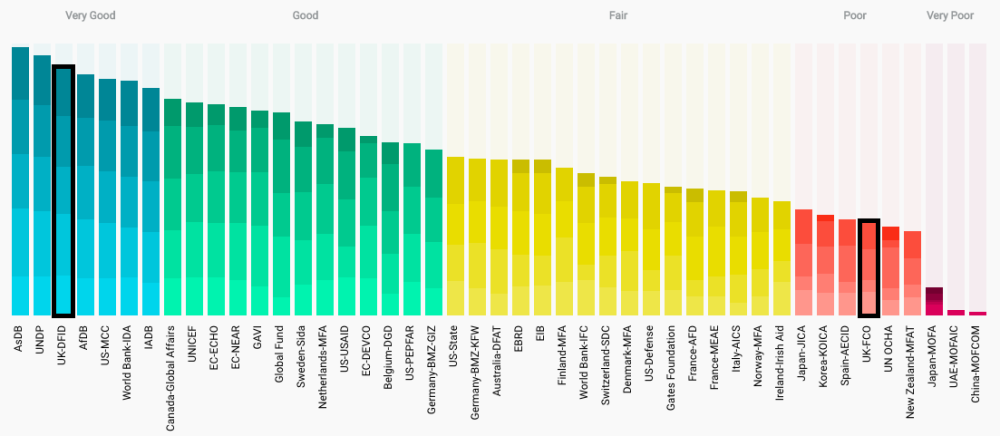The UK’s 2015 National Aid Strategy committed all departments to be “Very Good” or “Good” on Publish What You Fund’s Aid Transparency Index (“the Index”). We look at a leading indicator of transparency and conclude that, beyond DFID, progress has been almost non-existent. With a spending review to set budgets to 2022 expected next year, departments should take the last chance to step-up their performance and HM Treasury should not renew their spending if they don’t.
Why aid needs to be transparent
Since voters don’t experience aid directly, transparency is necessary to hold agencies accountable. If their local school, hospital, or roads aren’t up to scratch, voters notice and can punish MPs. As recipients of aid can’t vote in the UK and UK voters don’t experience aid, we need transparency to know whether aid is well spent.
The Government’s mid-term report card
In 2018, the Aid Transparency Index only ranked DFID and the FCO. The Index ranked DFID as the best performing European donor and best performing bilateral donor in 2018. The FCO was the worst performing European donor, with the same grade (“Poor”) that it’s held since 2013.
Figure 1. 2018 Aid Transparency Index
Source: Publish What You Fund
How are other departments doing?
The Index will rate other departments in 2020—but it’s important for us to see how departments are doing before the Spending Review next year. The International Development Parliamentary Select Committee (IDC) called on the government to “measure progress towards this commitment.” If the government is doing this, it’s not doing so publicly, so we’ve had a go.
Figure 2. Aid Transparency Index Score and IATI publishing frequency
Source: CGD analysis of Aid Transparency Index and IATI data
The Index looks at 35 indicators, but we focus on one: how often agencies publish data to the International Aid Transparency Initiative (IATI). Firstly, because this indicator affects the maximum score, agencies can get on other indicators. No agency publishing less than quarterly is ranked “Good” or “Very Good” (see Figure 2). So, although we can’t say for sure if a department IS on track to meet its target, we know if it ISN’T.
Secondly, publishing frequency is a good proxy for effort on transparency. If an agency aims to meet the target then publishing monthly is the first step, so generally agencies that publish frequently also do well on other indicators.
So, how do departments fare on publishing frequency?
Table 1. UK Government departments’ publishing frequency
| UK Department | UK Aid spent (2017) | Aid Transparency Index (2018) | IATI publishing frequency in 2018 |
|---|---|---|---|
| International Development (DFID) | £10,105m | Very Good | Monthly |
| Business, Energy & Industrial Strategy (BEIS) | £769m | n/a | < Annually |
| Foreign and Commonwealth Office (FCO) | £560m | Poor | Quarterly |
| Home Office | £335m | n/a | < Annually |
| Health and Social Care | £101m | n/a | Quarterly |
| Food and Rural Affairs | £67m | n/a | < Annually |
Source: CGD analysis of Aid Transparency Index and IATI data
Aside from DFID, no department is on track to meet the target so far. The FCO, to its credit, has improved its frequency, publishing three times this year. The Department of Health and Social care has also made an effort, publishing five times this year. However, BEIS (the 2nd biggest spender of UK aid) still publishes less than annually, despite being criticized by the IDC for its poor transparency in June this year, and despite the fact that the Department for Energy and Climate Change was publishing “meaningfully” to IATI before being subsumed by BEIS.
Publishing frequently is a necessary but insufficient condition for good transparency. Seven of the 23 agencies which publish monthly are still graded “Fair” to “Poor.” In 2018, the FCO was ranked “Poor” not only because it published infrequently, but because it did poorly on other indicators. Key pieces of information (performance indicators, tenders, contracts, finance and budget information, and country strategies) were not published at all, and because much of what was published was in a format that makes analysis difficult. To meet the target, departments will have to do much more than just publish frequently.
Show it or lose it
It’s disappointing that in three years since the 2015 Aid Strategy there has been so little progress outside DFID, but it’s not too late for departments to publish frequent, comprehensive and good quality data on their aid spending. Publishing is quick, simple and inexpensive if departments are collecting the information they should be.
In 2019, there is likely to be a Spending Review to allocate aid spending between departments for up to five years. Transparency was the only explicit and measurable target for departments in the UK National Aid Strategy. It is a key requirement of spending aid, essential for scrutiny, and for ensuring value for money. If departments can’t meet basic standards before the spending review begins then HM Treasury should hold back their funding.
International aid transparency architecture
International Aid Transparency Initiative (IATI)
- Function: Global initiative to improve aid transparency. Sets a standard to which agencies should publish data and keeps a registry of data published by 850 agencies
- Relationship: Used by Aid Transparency Index
Publish What You Fund (PWYF)
- Function: Global campaign for aid transparency
- Relationship: Publishes Aid Transparency Index
Aid Transparency Index (the Index)
- Function: Independent measure of aid transparency among the world’s major development agencies
- Relationship: Published by PWYF; uses IATI data
Disclaimer
CGD blog posts reflect the views of the authors, drawing on prior research and experience in their areas of expertise. CGD is a nonpartisan, independent organization and does not take institutional positions.






